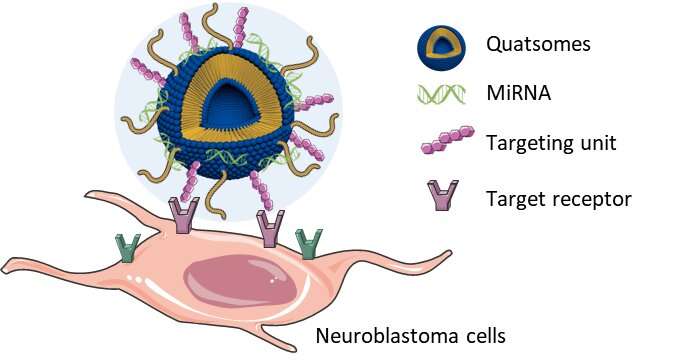Researchers at ICMAB present a study on new nanovesicles, known as quatsomes, which have been successfully engineered to encapsulate and deliver microRNAs for the treatment of tumors. These nanovesicles are produced by a simple GMP compliant process, an unavoidable requirement for the clinical use of new drug candidates. The study, published in Small, has been highlighted in the Women in Materials Science issue of Advanced Materials.
MicroRNAs (also known as miRNAs) are small RNA molecules that can interfere with the stability of other RNA molecules (specifically, messenger RNA). They have many potential therapeutic uses due to the central role they play in major diseases. However, these molecules are still infrequently used in patients due to their instability in the bloodstream and their poor ability to reach specific tissues. A potential strategy to improve the clinical delivery of miRNAs in the body is to encapsulate them in tiny carriers that compensate its current shortcomings, without side effects and offering other complementary functions.
To this end, researchers have developed and designed especially for this application nanostructures, known as quatsomes, composed by two closed lipid layers. In the new publication, the researchers present a newly engineered formulation of quatsomes that have a controlled structure, composition and pH sensitiveness.
The study is the result of an interdisciplinary team of researchers from the Institute of Materials Science of Barcelona, ICMAB-CSIC, the Vall d’Hebron Research Institute (VHIR)-UAB, the Institute for Bioengineering of Catalonia (IBEC), the Barcelona Institute of Science and Technology (BIST), the CIBER network on Bioengineering, Biomaterails and Nanomedicine (CIBER-BBN), the company Nanomol Technologies SL, the Technion-Israel Institute of Technology and the Institute for Complex Molecular Systems (ICMS).

“In this study we have collaborated with hospitals, research networks and companies. The successful results obtained illustrate the importance of collaboration across fields and beyond the academic system,” says Ventosa.
These new quatsomes can be coupled with the miRNA and injected intravenously into the body to be delivered in neuroblastoma primary tumors or in frequent sites of metastasis, such as the liver or lung, with a higher success and stability than if the miRNA were injected by itself. Once delivered, the miRNA has an effect on the cell proliferation and survival-related gens in the tumors, decreasing the tumor’s growth rate.
Many properties make quatsomes a good fit for these applications: they are less than 150 nm in size and are stable in a liquid solution for more than six months; they also have tunable pH sensitiveness, which means that different pH levels around can trigger different responses.
The production of these nanovesicles has been optimized with their final application in mind and to make sure they can be used in clinics. Through a green and scalable one-step process, named DELOS, researchers have designed a procedure that is fully compliant with Good Manufacturing Practice (GMP) guidelines stablished by the European Union. “It is time to translate our scientific findings for the benefit of patients,” says Ariadna Boloix, VHIR researcher.
In this publication, the functionality of quatsomes in delivering miRNAs is demonstrated with a specific extracranial solid tumor common in pediatric cases of cancer known as neuroblastoma, which is responsible for roughly 15 % of all pediatric cancer deaths and lacks therapies for high-risk patients. The results show that quatsomes protect the miRNA from degradation and increase its presence on liver, lung and xenografted neuroblastoma tumors, amongst other tissues.
News
Current Heart Health Guidelines Are Failing To Catch a Deadly Genetic Killer
New research reveals that standard screening misses most people with a common inherited cholesterol disorder. A Mayo Clinic study reports that current genetic screening guidelines overlook most people who have familial hypercholesterolemia, an inherited disorder that [...]
Scientists Identify the Evolutionary “Purpose” of Consciousness
Summary: Researchers at Ruhr University Bochum explore why consciousness evolved and why different species developed it in distinct ways. By comparing humans with birds, they show that complex awareness may arise through different neural architectures yet [...]
Novel mRNA therapy curbs antibiotic-resistant infections in preclinical lung models
Researchers at the Icahn School of Medicine at Mount Sinai and collaborators have reported early success with a novel mRNA-based therapy designed to combat antibiotic-resistant bacteria. The findings, published in Nature Biotechnology, show that in [...]
New skin-permeable polymer delivers insulin without needles
A breakthrough zwitterionic polymer slips through the skin’s toughest barriers, carrying insulin deep into tissue and normalizing blood sugar, offering patients a painless alternative to daily injections. A recent study published in the journal Nature examines [...]
Multifunctional Nanogels: A Breakthrough in Antibacterial Strategies
Antibiotic resistance is a growing concern - from human health to crop survival. A new study successfully uses nanogels to target and almost entirely inhibit the bacteria P. Aeruginosa. Recently published in Angewandte Chemie, the study [...]
Nanoflowers rejuvenate old and damaged human cells by replacing their mitochondria
Biomedical researchers at Texas A&M University may have discovered a way to stop or even reverse the decline of cellular energy production—a finding that could have revolutionary effects across medicine. Dr. Akhilesh K. Gaharwar [...]
The Stunning New Push to Protect the Invisible 99% of Life
Scientists worldwide have joined forces to build the first-ever roadmap for conserving Earth’s vast invisible majority—microbes. Their new IUCN Specialist Group reframes conservation by elevating microbial life to the same urgency as plants and [...]
Scientists Find a Way to Help the Brain Clear Alzheimer’s Plaques Naturally
Scientists have discovered that the brain may have a built-in way to fight Alzheimer’s. By activating a protein called Sox9, researchers were able to switch on star-shaped brain cells known as astrocytes and turn them into [...]
Vision can be rebooted in adults with amblyopia, study suggests
Temporarily anesthetizing the retina briefly reverts the activity of the visual system to that observed in early development and enables growth of responses to the amblyopic eye, new research shows. In the common vision [...]
Ultrasound-activated Nanoparticles Kill Liver Cancer and Activate Immune System
A new ultrasound-guided nanotherapy wipes out liver tumors while training the immune system to keep them from coming back. The study, published in Nano Today, introduces a biodegradable nanoparticle system that combines sonodynamic therapy and cell [...]
Magnetic nanoparticles that successfully navigate complex blood vessels may be ready for clinical trials
Every year, 12 million people worldwide suffer a stroke; many die or are permanently impaired. Currently, drugs are administered to dissolve the thrombus that blocks the blood vessel. These drugs spread throughout the entire [...]
Reviving Exhausted T Cells Sparks Powerful Cancer Tumor Elimination
Scientists have discovered how tumors secretly drain the energy from T cells—the immune system’s main cancer fighters—and how blocking that process can bring them back to life. The team found that cancer cells use [...]
Very low LDL-cholesterol correlates to fewer heart problems after stroke
Brigham and Women's Hospital's TIMI Study Group reports that in patients with prior ischemic stroke, very low achieved LDL-cholesterol correlated with fewer major adverse cardiovascular events and fewer recurrent strokes, without an apparent increase [...]
“Great Unified Microscope” Reveals Hidden Micro and Nano Worlds Inside Living Cells
University of Tokyo researchers have created a powerful new microscope that captures both forward- and back-scattered light at once, letting scientists see everything from large cell structures to tiny nanoscale particles in a single shot. Researchers [...]
Breakthrough Alzheimer’s Drug Has a Hidden Problem
Researchers in Japan found that although the Alzheimer’s drug lecanemab successfully removes amyloid plaques from the brain, it does not restore the brain’s waste-clearing system within the first few months of treatment. The study suggests that [...]
Concerning New Research Reveals Colon Cancer Is Skyrocketing in Adults Under 50
Colorectal cancer is striking younger adults at alarming rates, driven by lifestyle and genetic factors. Colorectal cancer (CRC) develops when abnormal cells grow uncontrollably in the colon or rectum, forming tumors that can eventually [...]





















